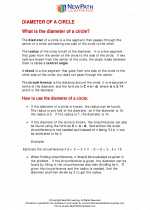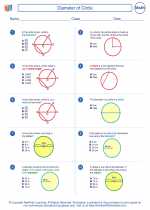Pyramid Study Guide
Definition
A pyramid is a three-dimensional shape that has a polygon as its base and triangular faces that meet at a common point called the apex.
Types of Pyramids
Pyramids can be classified into different types based on the shape of their base. Some common types of pyramids include:
- Triangular Pyramid: A pyramid with a triangular base.
- Square Pyramid: A pyramid with a square base.
- Pentagonal Pyramid: A pyramid with a pentagonal base.
Surface Area of a Pyramid
The surface area of a pyramid can be calculated using the formula:
Surface Area (A) = (Base Area) + (0.5 * Perimeter of Base * Slant Height)
Volume of a Pyramid
The volume of a pyramid can be calculated using the formula:
Volume (V) = (1/3) * (Base Area * Height)
Example Problems
Calculate the surface area and volume of a square pyramid with a base side length of 6 units and a height of 8 units.
Base Area = 6 * 6 = 36 square units
Perimeter of Base = 4 * 6 = 24 units
Slant Height (s) can be found using the Pythagorean theorem: s = √(h^2 + (0.5 * base)^2) = √(8^2 + 3^2) = √(64 + 9) = √73
Now, use the surface area formula to find:
Surface Area (A) = 36 + (0.5 * 24 * √73) ≈ 36 + 36.92 ≈ 72.92 square units
Now, use the volume formula to find:
Volume (V) = (1/3) * (36 * 8) = 96 cubic units
Real-life Examples
Pyramids are commonly found in architecture, such as the pyramids of Egypt, and in everyday objects like ice cream cones and roof structures.
Conclusion
Understanding the properties of pyramids, including their surface area and volume, is important in various fields such as geometry, architecture, and engineering.
.◂Math Worksheets and Study Guides Sixth Grade. Diameter of Circle

 Worksheet/Answer key
Worksheet/Answer key
 Worksheet/Answer key
Worksheet/Answer key
 Worksheet/Answer key
Worksheet/Answer key
